Readings Newsletter
Become a Readings Member to make your shopping experience even easier.
Sign in or sign up for free!
You’re not far away from qualifying for FREE standard shipping within Australia
You’ve qualified for FREE standard shipping within Australia
The cart is loading…






To the time-honored myth of the artist creating works of genius in isolation, with nothing but inspiration to guide him, art historians have added the mitigating influences of critics, dealers, and the public. Bodies of Art completes the picture by adding the model. This lively look at atelier politics through the lens of literature focuses in particular on the female model, with special attention to her race, ethnicity, and class. The result is a suggestive account of the rise and fall of the female model in nineteenth-century realism, a trend felt well into the twentieth century, especially in the new field of photography. This history of the model begins in nineteenth-century Paris, where the artist-model dynamic was regularly debated by writers and where the most important categories of models appear to be Jewish women, Italians, and Parisians. Bodies of Art traces an evolution in the representation of this model in realist and naturalist literary works from her birth in Balzac to her death in Maupassant, in the process revealing how she played a key role in theories of representation advanced by writers. Throughout the book, author Marie Lathers connects the artist’s work to the social realities and actual bodies that surround and inhabit the atelier. Her work shows how much the status of the model can tell us about artistic practices during the century of the birth of modernity. Marie Lathers is an associate professor of French at Iowa State University. She is the author of The Aesthetics of Artifice: Willier’s L'Eve future.
$9.00 standard shipping within Australia
FREE standard shipping within Australia for orders over $100.00
Express & International shipping calculated at checkout
To the time-honored myth of the artist creating works of genius in isolation, with nothing but inspiration to guide him, art historians have added the mitigating influences of critics, dealers, and the public. Bodies of Art completes the picture by adding the model. This lively look at atelier politics through the lens of literature focuses in particular on the female model, with special attention to her race, ethnicity, and class. The result is a suggestive account of the rise and fall of the female model in nineteenth-century realism, a trend felt well into the twentieth century, especially in the new field of photography. This history of the model begins in nineteenth-century Paris, where the artist-model dynamic was regularly debated by writers and where the most important categories of models appear to be Jewish women, Italians, and Parisians. Bodies of Art traces an evolution in the representation of this model in realist and naturalist literary works from her birth in Balzac to her death in Maupassant, in the process revealing how she played a key role in theories of representation advanced by writers. Throughout the book, author Marie Lathers connects the artist’s work to the social realities and actual bodies that surround and inhabit the atelier. Her work shows how much the status of the model can tell us about artistic practices during the century of the birth of modernity. Marie Lathers is an associate professor of French at Iowa State University. She is the author of The Aesthetics of Artifice: Willier’s L'Eve future.